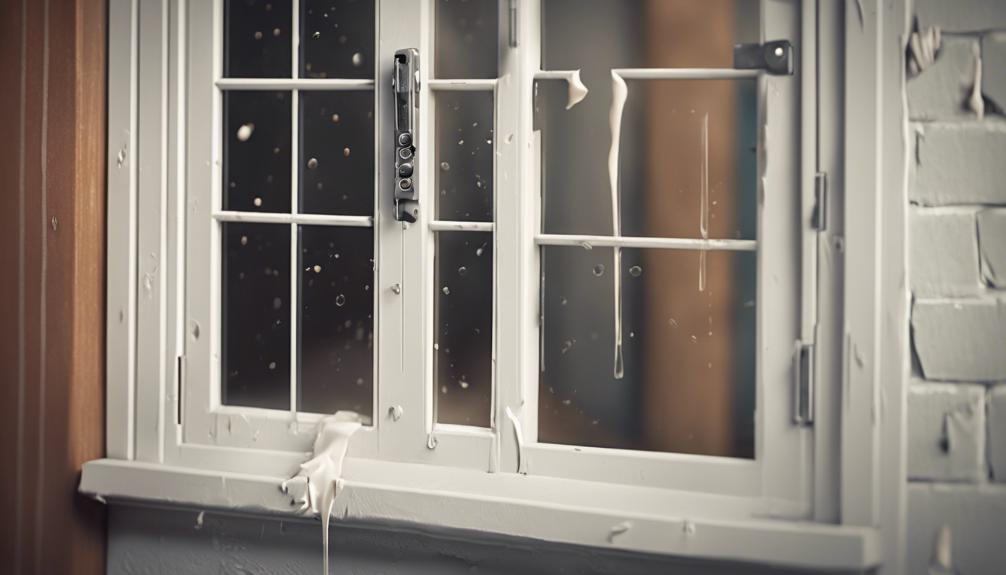Seal Air Leaks to Boost Energy Efficiency
Sealing air leaks in windows and doors reduces heat loss, minimizes cold drafts, and creates an energy-efficient home. Identify leaks on a windy day and inspect door frames for gaps and cracks. Prepare with caulk and weatherstripping.
Choose the right sealant for your window or door type and master bead application and tooling techniques. With the right tools and techniques, you'll reduce energy waste and optimize your home's energy efficiency.
Key Takeaways
• Identify air leaks around windows and doors using a lit candle or incense stick on a windy day to detect movement.
• Prepare the workspace by clearing the area, wearing gloves, and taking safety precautions before sealing air leaks.
• Choose the right sealant compatible with the window or door type, considering moisture resistance and temperature range.
• Seal gaps and cracks around doors, ensuring door alignment and securely attached thresholds.
• Master caulking and weatherstripping techniques, applying caulk at a 45-degree angle and installing weatherstripping firmly and evenly.
Identifying Air Leaks Around Windows

Identify air leaks around windows by performing a simple test on a windy day. Turn off all fans and HVAC systems. Hold a lit candle or incense stick near window frames and sashes. Observe the flame or smoke – if it flickers or moves towards the window, you've found an air leak.
This test identifies gaps in weatherstripping or worn-out seals. Conduct a thorough window inspection to identify glass deficiencies, such as cracks, gaps, or worn-out glazing compounds. Inspect window frames, sashes, and panes for damage or deterioration.
Check for loose or missing glazing points. Inspect glass edges for chips or cracks. Address any glass deficiencies before sealing air leaks for a successful outcome.
Preparing for the Sealing Process
Gather Essential Materials
For a successful sealing process, you need: caulk, weatherstripping, and a putty knife. Add a ladder, gloves, and safety glasses to ensure safety while working at heights or with caulk.
Prepare the Workspace
Clear the area around windows and doors from furniture and obstacles. Ensure a clean and dry workspace, free from debris. Place ladders on a level, firm surface, maintaining three points of contact.
Safety First
Wear gloves to protect hands from caulk and materials. Take safety precautions seriously, as minor accidents can hinder progress.
Get Ready to Seal
With necessary tools and materials, you're ready to tackle the sealing process. Proper preparation saves time and energy, ensuring a successful and effective air leak sealing process.
Choosing the Right Sealants

Choosing the Right Sealants
Select a sealant compatible with the window or door type and surrounding materials to ensure a durable seal.
Moisture Resistance
Sealants exposed to water or high humidity need high moisture resistance.
Temperature Range
Sealants subjected to extreme temperatures require a suitable temperature range.
Material Compatibility
Sealants must bond well with surrounding materials like wood, vinyl, or metal.
Sealant Durability
Sealant lifespan depends on the environment and usage; anticipate replacement timelines.
Sealing Air Leaks Around Doors
When sealing air leaks around doors, you'll need to focus on two key areas: gaps and cracks, and door frames.
You'll want to inspect the door frames carefully, checking for any signs of wear or damage that could be letting air escape.
Sealing Gaps and Cracks
Sealing gaps and cracks around doors is crucial to prevent heated or cooled air from escaping.
Inspect the following areas for gaps and cracks:
- The space between the door and frame, where the door sweeps or threshold meet the floor.
- The hinges, where the door attaches to the frame.
- The gap between the door frame and the surrounding wall, where insulation materials may be lacking.
- The area around the door's locking mechanism, where the door's locking bolts meet the frame.
Use various materials to seal these gaps and cracks effectively.
Inspecting Door Frames
Inspecting Door Frames for Air Leaks
Examine the door frame for gaps or cracks in the materials (wood, metal, or PVC) where it meets the surrounding wall and door attachment points.
Check the door's alignment; ensure it's properly hung and level. Misaligned doors create gaps between the door and frame, allowing air to escape.
Inspect door attachment points: hinges, screws, and other hardware. Look for loose or missing fasteners compromising the door's seal.
Check the door's threshold; ensure it's securely attached to the frame and floor. Gaps or cracks in the threshold allow air to leak in or out.
Caulking and Weatherstripping Techniques

As you prepare to seal air leaks around windows and doors, you'll need to choose the right type of caulk for the job. You'll have to take into account factors like durability, flexibility, and adhesion when selecting a caulk that can withstand the elements.
Next, you'll want to master various sealing techniques, including bead application and tooling, to guarantee a tight seal that lasts.
Types of Caulk
Types of Caulk
When sealing air leaks, three common types of caulk are used: silicone, polyurethane, and acrylic.
Silicone Caulk
Offers excellent flexibility and resistance to extreme temperatures. Ideal for applications where movement is expected. Benefits: high durability, resistance to mold and mildew.
Acrylic Caulk
A water-based option for interior applications, such as sealing gaps around windows and doors. Fills small gaps and cracks, easy to clean up with soap and water.
Polyurethane Caulk
A flexible and durable option for sealing larger gaps and joints. Suitable for exterior applications, provides excellent adhesion to various surfaces.
Specialized Caulk
For specific situations, such as high-temperature applications or fire-rated assemblies, specialized caulks are available to meet specific requirements.
Sealing Techniques
Proper Surface Preparation
Clean the surface with a soap and water mixture. Dry it completely before applying caulk or weatherstripping. This ensures a strong bond between the sealant and the surface.
Applying Caulk
Hold the caulk tube at a 45-degree angle. Squeeze out a small amount, using a smooth, continuous motion to fill the gap. Use a damp cloth to wipe away excess caulk that squeezes out beyond the joint.
Installing Weatherstripping
Cut weatherstripping to the correct length. Press it firmly into place, ensuring it's centered and even. Use a credit card or similar tool to press the weatherstripping firmly into the gap, making sure it's fully seated.
Additional Tips
Use spray insulation to fill gaps around windows and doors. Implement soundproofing methods to reduce noise and air leaks. These techniques ensure a tight seal, keeping warm air in and cold air out, reducing energy bills and improving energy efficiency.
Inspecting and Maintaining Seals
Inspect seals around windows and doors regularly to catch signs of wear or damage before they cause costly air leaks. Look for:
- Cracks or gaps in the sealant
- Fading, chalking, or brittleness of the seal material
- Loose or missing sealant around moving parts
- Water or air infiltration around the seal
Check the frame condition for rot, rust, or corrosion that could compromise the seal. Make repairs or replacements as needed to prevent air leaks.
A well-maintained seal is essential for optimal energy efficiency.
Measuring Energy Efficiency Impact

Quantifying Energy Efficiency Impact
Air leakage rates around windows and doors can be calculated to determine potential energy savings from repairs or replacements.
A blower door test or infrared camera detects air leaks.
Data analysis identifies areas with high air leakage rates, prioritizing repairs or replacements.
This data-driven approach optimizes energy efficiency, reducing energy consumption and costs.
Frequently Asked Questions
Can I Use Spray Foam to Seal Gaps Around Windows and Doors?
You can use spray foam to seal gaps around windows and doors, but choose the right type, such as low-expansion foam, and apply it correctly, using a low-pressure dispenser and thin, even layers to avoid overfilling.
How Often Should I Inspect and Reapply Seals Around Windows and Doors?
You should inspect and reapply seals around windows and doors seasonally, as weather patterns change, to guarantee maximum energy efficiency and prevent air leaks, which can lead to heat loss and increased energy bills.
Are There Any Eco-Friendly or Sustainable Sealant Options Available?
You'll find eco-friendly sealant options like natural adhesives derived from plant-based materials and sustainable coatings made from recycled content, offering a reduced environmental impact while still providing effective air-tight seals.
Can I Seal Air Leaks Myself or Do I Need a Professional?
You can seal air leaks yourself if you have DIY confidence, but for complex or multiple leaks, consider hiring a professional for a thorough evaluation to guarantee a complete seal.
Will Sealing Air Leaks Affect the Functionality of My Windows and Doors?
When sealing air leaks, you won't compromise your windows' and doors' functionality, as long as you maintain their weather resistance and structural integrity, ensuring smooth operation and preventing water infiltration or air leaks.
Conclusion
By sealing air leaks around windows and doors, you've taken an essential step towards improving energy efficiency. Your efforts will pay off in reduced energy bills and a more comfortable living space.
Remember to inspect and maintain seals regularly to guarantee peak performance. With the right techniques and materials, you'll be able to enjoy the long-term benefits of a more energy-efficient home.
